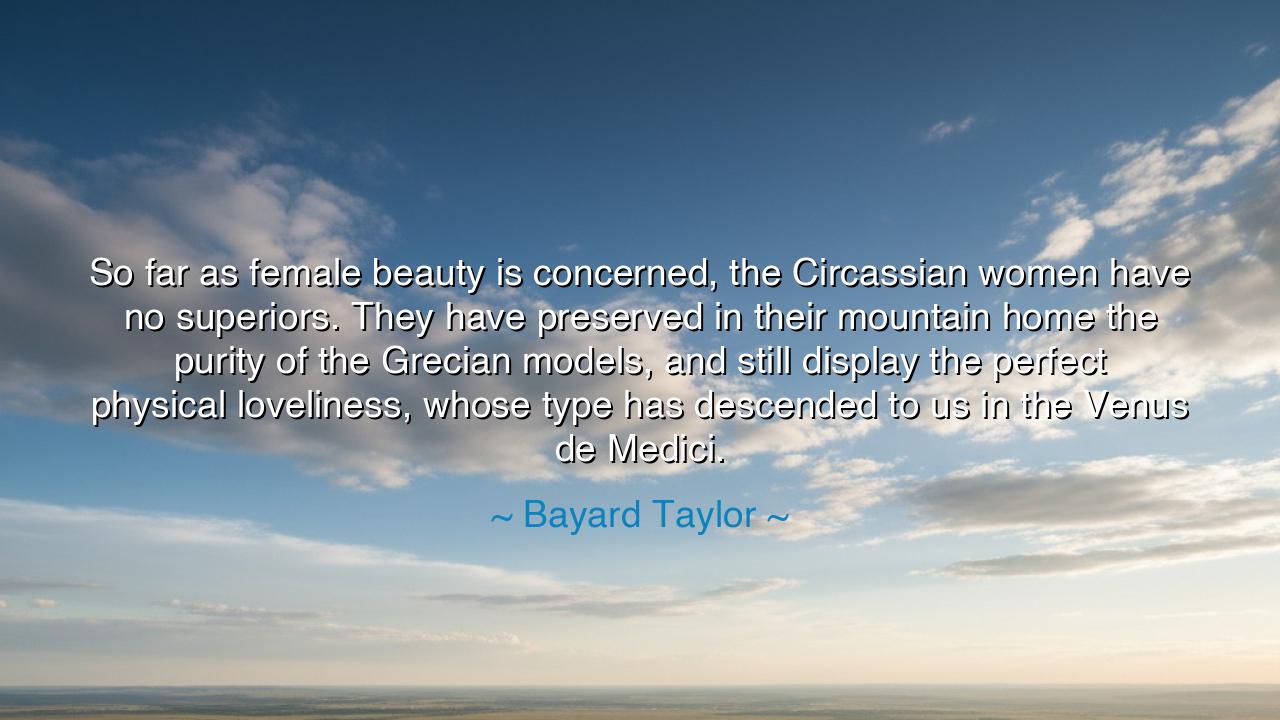
So far as female beauty is concerned, the Circassian women have
So far as female beauty is concerned, the Circassian women have no superiors. They have preserved in their mountain home the purity of the Grecian models, and still display the perfect physical loveliness, whose type has descended to us in the Venus de Medici.






In the words of Bayard Taylor, the poet, traveler, and chronicler of distant lands, we hear a voice steeped in awe and idealization: “So far as female beauty is concerned, the Circassian women have no superiors. They have preserved in their mountain home the purity of the Grecian models, and still display the perfect physical loveliness, whose type has descended to us in the Venus de Medici.” These words, written in the 19th century, belong to an age that sought beauty in both myth and geography — an age fascinated by the ancient ideal, where art, nature, and the human form converged in the pursuit of harmony. Yet within Taylor’s description lies more than admiration; it is a reflection of humanity’s eternal quest to define beauty, to locate it, and to preserve it against the eroding tides of time.
The Circassian women of whom he speaks inhabited the highlands of the Caucasus — a land where rugged peaks met the mists of legend. For centuries, travelers and poets from the West wrote of them as the very embodiment of grace and purity, untouched by the decadence of cities or the corruption of empires. Taylor, shaped by the romantic spirit of his age, looked upon them as living echoes of the Grecian ideal — that vision of perfect proportion and serene form first celebrated by sculptors like Phidias and immortalized in the Venus de Medici, the marble goddess whose beauty was said to capture the divine in human shape. To him, the Circassian woman was not merely a figure of flesh, but a symbol — a bridge between the mythic past and the fading nobility of nature’s design.
But let us look deeper, as the ancients would have, beyond the surface of his praise. For what Taylor truly speaks of is not only the loveliness of form, but the preservation of purity in an age of change. In those mountain strongholds, far from the empires that rose and fell like waves upon the earth, he saw a people unaltered — their beauty unshaken, their spirit unbent. To him, they represented what the Greeks once called kalokagathia — the union of the beautiful and the good. Beauty, in this older sense, was not vanity nor ornament, but an outward reflection of inner harmony. Thus, when Taylor wrote of “purity” and “model,” he spoke unconsciously of the soul as much as of the body — of that which is unaltered by corruption, steadfast and true to its essence.
The ancients, too, revered such ideals. In the temples of Athens, the statue of Aphrodite was not worshipped merely for her form, but for what she represented — balance, fertility, divine grace. The beauty of the body was a metaphor for the beauty of order, the symmetry of the cosmos itself. The Greeks saw in human perfection the echo of divine geometry — that same proportion that governs the stars and seas. Taylor’s words, though shaped by the lens of his century, carry an echo of this ancient philosophy: that true beauty is a harmony between nature and spirit, between the seen and unseen.
Yet, there is a paradox in his praise. For beauty that is “preserved” risks becoming a relic, an artifact admired but not understood. The Circassian women, romanticized by foreign eyes, were turned into symbols rather than seen as individuals. In their “purity” the Western imagination sought its own lost ideals. So too have many civilizations projected their longing for perfection upon others — forgetting that beauty is not found in isolation, but in the living breath of cultures that evolve. The Venus de Medici herself, carved from cold stone, is but a shadow of the living pulse that inspired her. Taylor’s admiration, though noble, reminds us that to idealize beauty without understanding it is to love the image more than the truth.
Still, there is something eternal in his yearning. It is the same longing that drives poets to describe the dawn, painters to chase the perfect light, and lovers to trace the face of their beloved as if it held the secret of eternity. Taylor’s gaze toward the mountains of Circassia was not only a traveler’s curiosity but the ancient human desire to find the unchanging in a changing world — to believe that somewhere, amidst the noise of civilization, beauty remains untouched. His words, though of another time, speak to a universal hunger: the search for purity, harmony, and meaning in an age that too often prizes the artificial over the real.
And so, let this reflection serve as a teaching: beauty is not born of imitation, but of authenticity. It is not preserved in marble or in memory, but in the living truth of what is natural, honest, and whole. The lesson of Bayard Taylor’s words is not to idolize the Circassians or the Grecians, but to recognize in them the enduring symbol of what beauty truly means — the alignment of soul and form, of strength and gentleness, of purity and purpose. In our own time, when images abound but meaning fades, we must remember this: beauty, like truth, dwells not in the perfection of appearance, but in the integrity of being. To seek that beauty — in ourselves, in others, and in the world — is to walk once more in the footsteps of the ancients.






AAdministratorAdministrator
Welcome, honored guests. Please leave a comment, we will respond soon